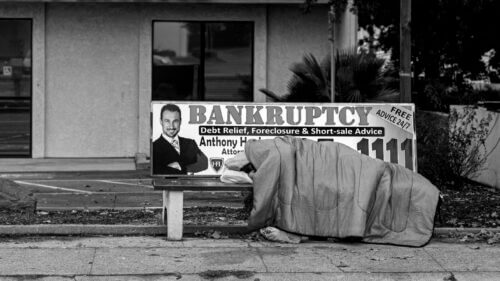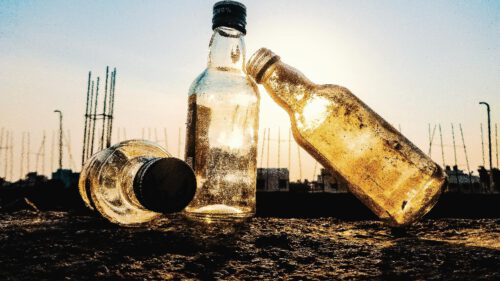The McKinsey company publishes for the first time a report that places the climate crisis as a major risk to economic activity. Will the business sector really start to change following the new report?
Ran Ben Michael, Angle - Science and Environment News Agency

The Global Risks Report recently released by the World Economic Forum examines the main threats to economic well-being in 2020 and the decade after. The five most serious risks (weighing of impact and chance of realization) are environmental: extreme weather, failure to address the climate crisis, man-made environmental disasters (such as environmental crimes, oil spills and radioactive pollution), loss of biodiversity, and natural disasters. A sixth risk - a water supply crisis - is associated with the category of geopolitical threats, but it is also environmental in nature. The publishers of the report believe that the business sector and its stakeholders - companies and corporations, investors, regulatory authorities, customers - must respond to these risks.
The consulting firm McKinsey is one of these stakeholders and also reaches similar conclusions. The "Global Institute", the company's internal think tank, released for the first time a report that presents the company's perception of the climate crisis and the economic risks that will reshape financial activities such as insurance and real estate.
Seven characteristics of risk
McKinsey's report assesses the degree of physical risk arising from the climate crisis, in the absence of adaptation activity or a recession; It is therefore based on the severe scenario of the International Panel on Climate Change, according to which the current rate of greenhouse gas emissions will continue "as usual".
According to McKinsey's experts, this risk has seven characteristics: it is increasing (its effects are intensifying), local (it has different manifestations in different sites depending on the conditions there), unstable and changing (warming will persist in the near term even if a level of zero emissions is reached), no - linear (after crossing a certain threshold, physical, ecological and human systems will collapse completely), multi-systemic (due to the global connection between human systems, its effects will cross borders), regressive (it affects poor economies more negatively) and the preparedness for it is limited (the adaptation to it needs to step up to bring about real achievements).
And in simpler words: the climate crisis is already here, it is getting stronger and its risks are increasing in an engineering column.
At the same time as the global average temperature increases, local, seasonal and specific changes occur. With these changes, climate threats increase and their scope expands. From a socio-economic point of view, these threats will manifest in five areas: health and work (for example, heatstroke will prevent people from working, especially outside, and will put their lives in danger); food production (mainly widespread failure in agricultural output); physical assets (such as destruction of buildings); physical infrastructures (damage to the supply of essential services such as transportation); and natural capital (benefits derived from functioning ecosystems).
economic-climatic inequality
The impact of the climate crisis on the economy has different faces: it creates one-time risks, such as extreme weather events or huge fires, and ongoing risks, such as changing the water and sediment cycle or the disappearance of fish from the sea. Both of these translate into trillions of dollars in damages and morbidity or mortality among hundreds of millions.
The report examines nine research cases that are examples of the issues countries will face in the five areas of influence of the crisis. Thus, in the Mediterranean basin the two main sectors of economic activity - agriculture and tourism - will be affected; The expected long droughts and severe heat waves will reduce the agricultural harvest and reduce the attractiveness for tourists. In Florida, by 2050 sea level rise will reduce real estate values by 15-35 percent ($80-30 billion) and with it tax revenues, which will reduce the ability to invest in infrastructure restoration or other adaptation efforts.
Along with this, the insurance costs and expenses of the insurance companies to cover the damages will grow, which will make the current insurance products possibly irrelevant. In India, loss of working hours and reduced productivity due to heat waves and humidity will reduce GDP by about 4.5 percent. The chance of extreme rain events in Southeast China, where rare ores that are part of the electronics industry are mined, currently stands at 2.5 percent per year and rises to 4 and 6 percent in 2030 and 2050 respectively; Such an event disrupts the global supply chain and increases commodity prices.
"Although there are adaptation measures that can be carried out more easily - such as, for example, designing buildings so that they are more durable," explains Dr. Uri Sharon, vice president of the Israeli Association for Ecology and Environmental Sciences, "but there are some that are difficult to achieve, such as genetic engineering of Agricultural varieties are adapted, and there are those that cannot be carried out, for example making the human body work normally in a temperature of 45 degrees. Recognizing the limitations that the climate crisis places on us is a key point."
Each of the 105 countries surveyed in the report will face at least one threat by 2030, but countries with a low gross domestic product are, as a rule, more sensitive to the risks posed by the climate crisis. By the year 2050, the risk of countries in the bottom quartile of GDP increases by 5 to 10 percent on average compared to 0.3 to 1 percent for the countries in the top quartile. These countries are characterized by work outside the buildings (low level of industrialization), dependence on natural capital (mainly for agriculture) and low preparedness for a crisis (due to a lack of financial resources). This exposure will only increase because they will find it difficult to purchase insurance to protect their infrastructure or their credit rating will deteriorate further and their ability to borrow money in the global market will be limited.

Is the change starting?
Although the report is based on existing knowledge, its authors believe that the business sector still does not take into account the unfolding effects of the climate crisis and clarify that the crisis "should be a major factor in decision-making. For corporations, the intention is that the climate issue should be taken into account, among other things, when allocating capital, developing products and services and managing the supply chain"; The insurance sector is an example of one that must change quickly to adapt to the realizing risk of the climate crisis.
There are many examples that the wave of change may already be starting: in his annual letter to fellow CEOs in January of this year, Larry Fink, CEO of the giant investment company BlackRock, which manages about 7 trillion dollars, devoted most of his attention to the exciting change in the financial system due to the crisis The climate and the positioning of sustainability at the center of the company's investment strategy. When a significant economic body expands its progressive climate policy, this is a significant step also in relation to many countries.
"The McKinsey report may not be much new for those in the know," adds Sharon, "but it includes the findings of many studies and analyzes about the negative impact of the climate crisis on the economy. The internalization of the insight that the climate crisis is already here and that the economic activity on the part of pioneers such as McKinsey and Blackrock must also be adapted to it may accelerate the adoption of new economic practices. On the other hand, there is a very dangerous signal here. We expect countries and their regulatory mechanisms to act to reduce future risks with the understanding that the free market does not always know how to provide efficient results that contribute to the general welfare and that the role of the institutions is, among other things, to bring order and prevent losses resulting from market failures. Most of the time, if the state does not intervene, the market mechanisms come into action late and the private market factors intervene after the risks have already materialized to 'fix' their losses".
More of the topic in Hayadan:
The giant fires in Australia: the media downplays the connection to the climate crisis
The Swedish girl Greta Thunberg warns: my generation will bear the consequences of the lack of actions to stop the climate crisis
The students' climate protest proves: it's time to create a new economy

3 תגובות
When the facts bother you, you also rewrite
Very important article
Thanks
The things here do not take into account the fact that any warming will also bring cold areas to be conditioned and more suitable for activity. That is why the activity areas should be moved to the north and good isolation buildings should be built in the south and less so in the north. Accepting global warming as a fact also requires proof. There is definitely local warming at the poles and certain areas. But there are many areas where he didn't show real warming and sometimes even cooling. The report uses, according to its statement, previous sources. It is necessary to segment them and return to primary sources such as climate measurements in the various areas. A few cold or hot years are not evidence of processes.